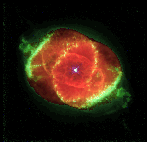 WFPC-2 Image of NGC 6543 courtesy of J.P.
Harrington and NASA
WFPC-2 Image of NGC 6543 courtesy of J.P.
Harrington and NASA WFPC-2 Image of NGC 6543 courtesy of J.P.
Harrington and NASA
WFPC-2 Image of NGC 6543 courtesy of J.P.
Harrington and NASAWelcome to the Nebular Analysis Software Resources page. You may retrieve the nebular software, or run the tasks temden and ionic, which are both part of this package. These applications make use of the N-level atom approximation to compute electron temperature, density, ionic abunances, and other quantities for a low-density (i.e., nebular) gas. General information about the nebular package is available, as is detailed information about the N-level atom approximation.
Thirteen new ions of C, O, Ne, Na, Mg, Al, Si, S, Cl, K, and Ca have been added to the set of those previously supported, and as a consequence, 15 new electron density or temperature diagnostics are also available, which span a much greater range of density, temperature, and ionization.
The ntcontour task has been substantially enhanced, and has an interactive option. It is now possible to customize the diagnostic to the ratio of any of the available atomic transitions. This task is particularly useful for determining the range of N_e and T_e where a particular diagnostic is sensitive, for investigating non-traditional diagnostics, and for estimating the consequences of a given level of uncertainty in an observed line ratio.
You may obtain the nebular package by retreiving and installing the STSDAS package (V2.0 or later), or you may retrieve the nebular package for personal installation, provided you have TABLES (V2.0 or later) installed. All of this software is layered on IRAF, which can be obtained from NOAO.
Fill-out forms are available to allow you to:
The on-line "Catalog of Relative Emission Line Intensities Observed in Planetary Nebulae" (ELCAT for short) is an electronic listing of fluxes on over 1000 planetary nebulae that have been published in the astronomical literature through mid-1994. This catalog, and the ancillary information, are available for on-line browsing, WAIS searches, and retrieval through WWW and ftp.
![]()
This project was funded by the NASA Astrophysics Data Program through grant NAG5-1432 to Space Telescope Science Institute; supplemental funding was provided through an STScI internal research grant.
![]()
NEBULAR home page · Ionic task · Temden task
Copyright © 1997 The Association of Universities for Research in Astronomy, Inc. All Rights Reserved.
Last modified 21 February 2005